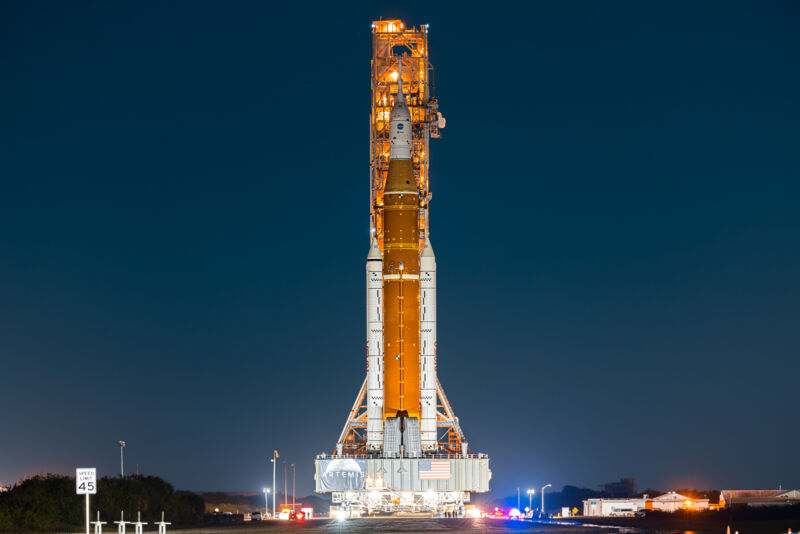
In a new report, the federal department charged with analyzing how efficiently US taxpayer dollars are spent, the Government Accountability Office, says NASA lacks transparency on the true costs of its Space Launch System rocket program.
Published on Thursday, the new report (see .pdf) examines the billions of dollars spent by NASA on development of the massive rocket, which made a successful debut launch in late 2022 with the Artemis I mission. Surprisingly, as part of the reporting process, NASA officials admitted the rocket was too expensive to support its lunar exploration efforts as part of the Artemis program.
"Senior NASA officials told GAO that at current cost levels, the SLS program is unaffordable," the new report states.
Poor tools to understand true costs
The Government Accountability Office expressed serious concerns about NASA's decision to not measure production costs of SLS rocket elements including the core stages and rocket engines needed for future launches. Instead, NASA told the report authors that it plans to "monitor production costs and affordability of the SLS program via the five-year production and operations cost estimate."
However, the report states, these are "poor tools" for a cost baseline for the SLS rocket program and will make it difficult for taxpayers to measure costs and the performance of NASA and its contractors over time. Moreover, the report indicates that NASA has not regularly updated its five-year production cost estimates for the rocket. The report also cites concerns about development costs of future hardware for NASA's big-ticket rocket program, including the Exploration Upper Stage.
Another problem with NASA's cost estimates is that they do not appear to account for delays to Artemis missions. It is probable that the Artemis II mission, a crewed flight around the Moon, will launch no earlier than 2025. The Artemis III crewed landing is likely to slip to at least 2026 if not more, with additional delays down the line. At least one NASA official apparently told the Government Accountability Office that these delays would have no cost impacts, which seems highly improbable.
"Some NASA officials told us that changes to Artemis mission dates should not affect the SLS program’s cost estimate," the report states. "Other officials noted that the program’s cost estimate would be expected to increase to account for the delay to the Artemis IV mission, which shifted from 2026 to 2028."
How to pare back unsustainable costs
NASA officials interviewed by the Government Accountability Office acknowledged that they were concerned about the costs of the SLS rocket.
"NASA recognizes the need to improve the affordability of the SLS program and is taking steps to do so," the report states. "Senior agency officials have told us that at current cost levels the SLS program is unsustainable and exceeds what NASA officials believe will be available for its Artemis missions."
Officials from the space agency said they had a four-step plan to reduce costs of the SLS rocket program over time:
- Stabilize the flight schedule
- Achieve learning curve efficiencies
- Encourage innovation
- Adjust acquisition strategies to reduce cost risk
Setting aside that some of these goals sound suspiciously like corporate speak, the report makes clear that these are aspirational aims for now. "NASA, however, has not yet identified specific program-level cost-saving goals which it hopes to achieve," the authors write. "NASA has made some progress toward implementing these strategies, but it is too early to fully evaluate their effect on cost."
Can NASA really control costs?
While NASA certainly deserves credit for talking about the excessive cost of the SLS rocket—a fact that has been pointed out by critics for more than a decade but largely ignored by NASA officials and congressional leaders—it is not at all clear that they will be able to control costs. For example, NASA recently said that it is working with the primary contractor of the SLS rocket's main engines, Aerojet, to reduce the cost of each engine by 30 percent, down to $70.5 million by the end of this decade.
However, NASA's own inspector general, Paul Martin, said this claim was dubious. According to Martin, when calculating the projected cost savings of the new RS-25 engines, NASA and Aerojet only included material, engineering support, and touch labor, while project management and overhead costs are excluded.
And even at $70.5 million, these engines are very, very far from being affordable compared to the existing US commercial market for powerful rocket engines. Blue Origin manufactures an engine of comparable power and size, the BE-4, for less than $20 million. And SpaceX is seeking to push the similarly powerful Raptor rocket engine costs even lower, to less than $1 million per engine.



3175x175(CURRENT).thumb.jpg.b05acc060982b36f5891ba728e6d953c.jpg)
Recommended Comments
There are no comments to display.
Join the conversation
You can post now and register later. If you have an account, sign in now to post with your account.
Note: Your post will require moderator approval before it will be visible.